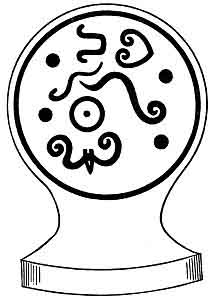
Sacred Texts Atlantis


|
The Sacred Symbols of Muby James Churchward[1933, copyright not renewed] |
This is the third book in James Churchward's Mu series, one of several which slipped into the public domain in the US because some paperwork wasn't submitted on time to the copyright office. This one seemed to be the most on-topic for this site.
According to Churchward, Mu was a lost continent in the Pacific Ocean, which was destroyed in a global cataclysm tens of thousands of years ago; Mu was the original home of mankind, and all subsequent civilizations descended from it. The Pacific islands and their inhabitants are supposed to be the last survivors of this primordial motherland. Churchward's Mu was a huge continent, which stretched from Micronesia in the West to Easter Island and Hawaii in the East. Churchward also believed in a literal mid-Atlantic Atlantis. He proposed a global network of huge gas-filled caverns which, if vented, could cause large areas of land to be submerged.
Churchward served with the British Army for thirty years. He claimed that, while posted in India, he befriended a priest ('Rishi'), who revealed to him ancient tablets written in an otherwise unknown language. The Rishi taught Churchward how to read this language, Naacal. The tablets described the land of Mu, the Lemuria of the Theosophists. He also claimed that he was able to discern writing from Mu on a mysterious set of tablets discovered in Mexico by an explorer named William Niven.
Churchward's Mu theory hasn't achieved even the marginal credibility of Atlantis. For one thing, his science is absurd. The Pacific appears to have been free of large land masses for billions of years. In fact, the Pacific basin may mark the place where the Moon was expelled from the proto-earth. Coral atolls that dot the Pacific have taken millions of undisturbed years of activity to form. And the Pacific was one of the last regions on the planet to be settled by humans; this is proven by linguistic evidence, and the well-documented oral traditions which describe the history of the Polynesian migrations.
It doesn't help matters that Churchward's books are largely absent of apparatus such as footnotes or bibliography, and his basic source material cannot be independently confirmed. In his Mu-monomania, he employs circular and tautological reasoning. Often, he will make a startling assertion, and before supporting it, will move on to some other train of thought. At other times, he writes factually about, say, Egyptian mythology, without any clue for the reader as to why this proves anything about Mu. The reader is simultaneously entertained and irritated by this intellectual shell game.
However, Churchward may have the last laugh yet. There was a large land mass in the Pacific that was submerged during prehistoric times: Sundaland, the continental shelf around Indonesia, which was exposed during the ice ages. It was most certainly the route that humans used to get to Australia, as only a few kilometers of water separated Sundaland from Australia at that time. Although it was submerged slowly as the result of rising sea levels at the end of the ice age, the region has some of the most violent volcanoes on Earth (such as the famous Krakatoa). A documented eruption in that region about 60,000 years ago may have decimated the human race, producing a 'population bottleneck' during which our species was reduced to a few hundred individuals; this has emerged from mitochondrial DNA studies. Some have hypothesized that Sundaland may have been home to an early lost civilization, perhaps the home of the mysterious voyagers who charted the anomalous ice-age maps which the early modern map-makers incorporated in their atlases. While not Mu or Lemuria, of all of the nooks and crannies where a lost civilization might have existed, Sundaland is one of the most plausible; only time will tell.
--J. B. Hare